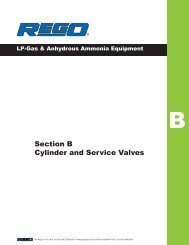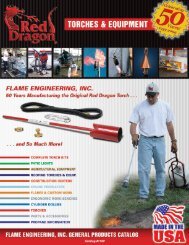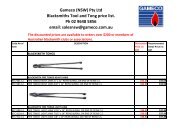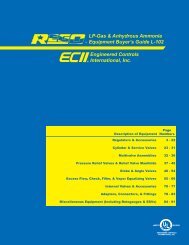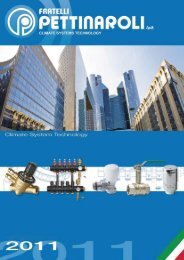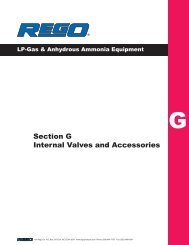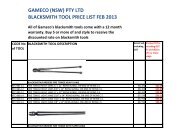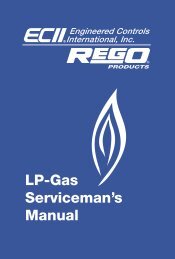Repair Kits Available By Part Number Section 2 Page - GAMECO
Repair Kits Available By Part Number Section 2 Page - GAMECO
Repair Kits Available By Part Number Section 2 Page - GAMECO
Create successful ePaper yourself
Turn your PDF publications into a flip-book with our unique Google optimized e-Paper software.
WARNING: Installation, usage and maintenance of this product<br />
must be in compliance with all Engineered Controls International,<br />
Inc. instructions as well as requirements and provisions<br />
of NFPA #54, NFPA #58, DOT, ANSI, all applicable<br />
federal, state, provincial, and local standards, codes, regulations<br />
and laws.<br />
This valve must remain in the closed position except during<br />
product transfer. A line break downstream of the pump may fail<br />
to actuate the excess flow valve as the pump may limit flow. If<br />
a break occurs in the system, or the excess flow closes,<br />
immediately shut down the system.<br />
Inspection and maintenance on a periodic basis is essential.<br />
How the Valve Works:<br />
1. Normally Closed<br />
While the valve is closed, liquid flows into the INLET PORTS,<br />
and through a channel in the PISTON into area A. It also flows<br />
down through the PRIMING CHANNEL in the valve body, into<br />
area B beneath the valve seat -- and into area C to prime the<br />
PUMP.<br />
Installation, disassembly, repair and maintenance must be<br />
performed only by qualified personnel.<br />
Be sure all instructions are read and understood before installation,<br />
operation and maintenance. These instructions must be<br />
passed along to the end user of the product.<br />
CAUTION: Contact or inhalation of liquid propane, ammonia and<br />
their vapors can cause serious injury or death! NH3 and LP-Gas<br />
must be released outdoors in air currents that will insure dispersion<br />
to prevent exposure to people and livestock. LP-Gas must<br />
be kept far enough from any open flame or other source of<br />
ignition to prevent fire or explosion! LP-Gas is heavier than air<br />
and may not disperse or evaporate rapidly if released in still air.<br />
2. Pump on — Valve Opening<br />
When the pump is started, differential pressure transmits through<br />
the 1 /4” piping into chamber D, lifting the PILOT STEM. This<br />
opens the seat between the stem and piston at E. Pump suction<br />
then evacuates the tank pressure in area A, which becomes<br />
equal to the pump suction pressure.<br />
Piston<br />
A<br />
A<br />
Inlet Ports<br />
Priming Channel<br />
Piston<br />
E<br />
Pilot Stem<br />
B<br />
1<br />
/4” Pump<br />
Discharge<br />
Line<br />
D<br />
C<br />
Pump<br />
3. Pump On — Valve Open<br />
Tank pressure exerted on the X-RING SEAL forces the PISTON<br />
up to open the valve. This rotates the INDICATOR SLOT to its<br />
vertical (valve open) position. The pump differential pressure in<br />
area D holds the PILOT STEM and PISTON open. Approximately<br />
18 psig pump differential pressure is required to open the<br />
valve and approximately 8 psig differential pressure will hold the<br />
valve open.<br />
4. Pump Off — Valve Closes<br />
With the pump shut off, the pressure in area D which holds the<br />
valve open, bleeds out through the # 60 DRILL ORIFICE. This<br />
loss of pressure permits the SPRING to push the PILOT STEM<br />
down and re-seat at point E. Since pressures are equal above<br />
and below the PISTON, with no sustaining pressure in area D,<br />
the SPRING forces the valve closed. The INDICATOR SLOT<br />
rotates to the horizontal (valve closed) position.<br />
Piston<br />
X-Ring<br />
Seal<br />
Piston<br />
Spring<br />
E<br />
Indicator<br />
Slot<br />
Pilot Stem<br />
Indicator<br />
Slot<br />
Pilot Stem<br />
D<br />
No. 60<br />
Drill<br />
Orifice



